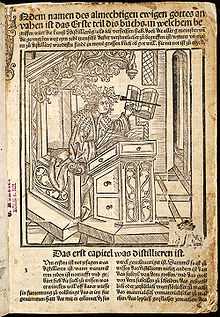Hieronymus Brunschwig
| Hieronymus Brunschwig | |
|---|---|
 the title page of Brunschwig's famous work, Liber de arte distillandi simplicia et composita. | |
| Born |
1450 Strasbourg |
| Died |
1512 Strasbourg |
| Residence | Strasbourg |
| Nationality | German |
| Known for | Liber de arte distillandi de compositis |
Hieronymus Brunschwig or Hier Brunschwygk (ca. 1450 – ca. 1512), was a German physician, surgeon, chemist, and pharmacologist. He was notable for his early work on chemical techniques, as well as his methods of treatment of gunshot wounds. He authored several books, including Liber de arte distillandi simplicia et composita.
Life
Brunschwig was born circa 1450 in the free imperial city of Strasbourg, which in his time was part of the Holy Roman Empire. He studied medicine at the universities of Bologna, Padua, and Paris. After practising in Alsace, Franconia, and Bavaria, he settled at Strasbourg at the end of the fifteenth century. He died in Strasbourg, circa 1512.
Early publications

Brunschwig's early publications, all printed in Strasbourg by Johann Grüninger, included treatises on surgery and anatomy:
- 1497: Das buch der cirurgia: hantwirckung der wundartzny
- 1497: A most excellent and perfecte homish apothecarye or homely physick booke
Liber de arte distillandi simplicia et composita
.jpg)

Brunschwig's Liber de arte distillandi simplicia et composita (also known as the "Little Book of Distillation") was one of the earliest books ever written concerning the subjects of chemistry and pharmacology. Printed by Grüninger in 1500,[1] this book was the first to systematically describe the essential oils, their distillation and extraction from the plants which produce them, and their applications as pharmacotherapeutic agents.
The first part of the treatise describes in great detail the methods and apparati for the distillation of extracts from various plants and animals. The second part describes certain medicinal plants, and the third part contains an exhaustive list of maladies (such as marital incompatibility, poor memory, depression, nightmares and alcohol intoxication) along with a corresponding list of plant distillates and extracts recommended for their treatment. The book includes instructions on how to distill aqua vitae, aurum potabile, and artificial and natural balsams.
The last of the fifteenth-century herbals, this book is widely regarded to be an important link between the Middle Ages and modern times. Due to its in-depth description and many illustrations of distillation apparati and techniques, the book was considered to be an authoritative text well into the 16th century.
Posthumous publications
- 1521: Destillierbuch . Grüninger, Straßburg Digital edition by the University and State Library Düsseldorf
- 1527: Apoteck für den gemainen man
- 1527: The vertuose boke of distyllacyon of the waters of all maner of herbes
- 1541: Hauß apoteck, Zu yeden leibs gebresten, für den gemainen man, vnd das arm Landuolck . Stayner, Augspurg Digital edition by the University and State Library Düsseldorf
- 1561: New vollkom[m]en distillierbuch wolgegründter künstlicher distillation
- 1597: The noble experyence of the vertuous handy warke of surgeri
Notes
- ↑ Bertrand Gille, Histoire des techniques (1978), ISBN 978-2-07-010881-7.
External links
- Turning the Pages: a virtual copy of Brunschwig’s Liber de arte distillandi de compositis. From the U.S. National Library of Medicine.
- Hieronymus Brunschwig ou le premier traité imprimé de chirurgie
| |||||||||||||||||||||||||||
